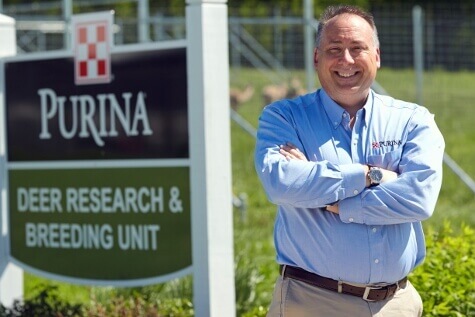
The Impact of Heat Stress on Deer
Deer : Nutrition
Deer : Management
Each species has a specific thermoneutral zone (TNZ) where the animal feels comfortable. At temperatures below and above the TNZ, the metabolic rate increases to keep the body warmer or cooler. Due to the increased metabolic rate, a greater amount of energy is needed and therefore negatively impacts health and productivity parameters. The temperature range for the TNZ is also affected by moisture, wind chill, solar radiation, body condition and haircoat. In white-tailed deer, the transitional hair coat in the fall offered more protection against temperature extremes than the summer coat and results in a larger TNZ.5
Heat stress occurs when the temperature or temperature-humidity indices (a combination of ambient temperature and relative humidity) go above the upper critical temperature of the TNZ. For northern white-tailed deer the upper critical temperature is 68°F during the summer and 77° in the winter.5 See Table 1 for the TNZ of selected cervid species.
White-tailed deer reduce movement, spend more time lying, seek cooler locations, look for shelter from solar radiation, and pant to dissipate heat during heat stress.5 As panting increases, there is an increased risk of rumen acidosis due to a decrease in rumen buffering capacity through increased exhalation of CO2 and loss of saliva by drooling.1 Elk rarely pant, but sweat to cool off.6 Deer under climatic stress, like heat, can have a negative effect on nutritional status at a time when growth, lactation, and antler production occurs. This reduction in productive activity is partly due to reduced feed intake, altered endocrine status, reduced rumination, nutrient absorption and increased maintenance requirements.1 This results in reduced energy and nutrient availability. If heat stress occurs and results in a negative energy balance just after fawning, there could be an increased risk of metabolic disorders, health problems, decreased milk yield and reduced reproductive performance.3 Reduced nutrient intake during lactation can also lead to inefficient nitrogen incorporation into microbial proteins in the rumen and loss of amino acids that were mobilized from skeletal muscle.1 Feed conversion efficiency is reduced in part due to increased energy expended to rid the body of excess heat and reduced digestibility of higher fiber forages.4
The goal is to reduce the potential impact of heat stress to keep animals eating and in positive energy balance. One of those management activities could be to provide additional cover in the form of improved habitat, stands of trees or artificial shade structures.7 Because water is important to help dissipate heat, make sure deer have access to fresh water near every feeder or every 300 acres.7
Through Purina’s deer research program, a patent-pending mixture of plant extracts, Climate Guard® supplement, was identified that support deer during climatic stress events like heat. Climate Guard® supplement has been added to all Purina® AntlerMax® deer feed, except AntlerMax® Deer Mineral and Extreme Energy™ supplement.
| Table 1. Thermoneutral zones for selected cervid species | ||||
|---|---|---|---|---|
| Thermoneutral Zone | ||||
| Specie | SeasonA | Lower Critical temperature, F |
Upper critical temperature, F |
Reference |
| White-tailed deer | Sp, Su, Fa Wn |
41 41 |
68 77 |
1Holter et al., 1975 1Holter et al., 1975 |
| Black-tailed deer | Su Wn |
53.6 21.2 |
80.6 64.4 |
2Bunnell, 1990 2Bunnell, 1990 |
| Mule deer | Su Wn |
-4 -4 |
77 41 |
5Paker & Robins, 1984 5Paker & Robins, 1984 |
| Elk | Wn | -4 | 68 | 6Paker & Robins, 1984 |
| ASp=Spring, Su=Summer, Fa=Fall, Wn=Winter | ||||
1Bernabucci, U., N. Lacetera, L.H. Baumgard, R.P. Rhoads, B. Ronchi, and A. Nardone. 2010. Metabolic and hormonal acclimation to heat stress in domesticated ruminants. Animal 4:1167-1183.
2Bunnell, F.L. 1990. Ecology of black-tailed deer. In: Deer and Elk Habitats in Coastal Forests of Southern British Columbia, J.B. Nyberg and D.W. Janz, eds. Research Branch, Ministry of Forests, Province of British Columbia, Victoria, pp 31-63.
3Drackley, J.K. 1999. Biology of dairy cows during the transition period: The final frontier? Journal of Dairy Science. 82:2259-2273.
4Fuquay, J.W. 1981. Heat stress as it affects animal production. Journal of Animal Science. 52:164-174.
5Holter, J.B., W.E. Urban, Jr., H.H. Hayes, H. Silver, and H.R. Skutt. 1975. Ambient temperature effects on physiological traits of white-tailed deer. Canadian Journal of Zoology. 53:679-685.
6Parker, K.L., and C.T. Robbins. 1984. Thermoregulation in mule deer and elk. Canadian Journal of Zoology. 62:1409-1422.
7Schreiber, C. 2015. Research suggest south Texas heat impacts deer productivity. Texas Wildlife. August:50-51.
8Silanikove, N. 2000. Effects of heat stress on the welfare of extensively managed domestic ruminants. Livestock Production Science. 67:1-18.
9Tomeček, J.M. and M. Russell, 2016. Managing heat for wildlife on Texas rangelands. Texas A&M AgriLife Extension Service. EWF=034. Available at: https://agrilifeextension.tamu.edu/wp-content/uploads/2016/07/Managing-Heat-for-Wildlife-on-Texas-Rangelands.pdf



